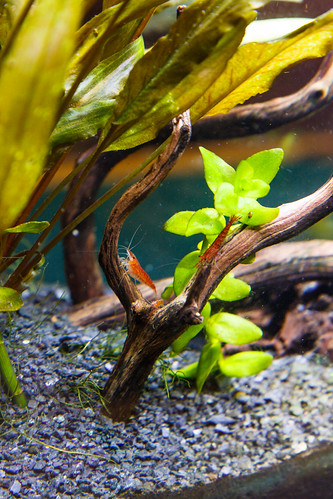Even when planning a simple low light planted tank like our Spec V, there is much to decide – everything from types of plants to the brand and type of substrate. In trying to decide what I wanted in the substrate for our aquarium, I had a few criterion that I wanted filled:
- For the look of our aquarium, I wanted black, or very dark, substrate.
- I wanted medium to small grain size.
- I wanted a long-lasting substrate solution – not one that would need to be replaced every year or two.
- A substrate that would promote healthy growth for the plants in our low light aquarium
I ended up selecting Seachem Flourite Black as the substrate in our tank.
The substrate has generally filled all the requirements that I had for a substrate.
What is Seachem Flourite:
Some substrates, like ADA Aquasoil or UP Aqua Soil, or even Eco Complete, are more organic in nature and provide nutrients directly from them to the roots of your aquarium plants. Seachem Flourite is different. From their website:
“Flourite® is a specially fracted, stable porous clay gravel for the natural planted aquarium.”
“Flourite® never has to be replaced. It remains effective for the life of the aquarium. Flourite® is not chemically coated or treated and will not alter the pH of the water.”
The product is described as clay gravel and is basically inert by itself, however, when fertilizers are added, either to the water column or by way of fertilizing root tabs, the fertilizers are transferred to the Flourite. I have heard it described as charging a battery when the compounds are transferred to the Flourite. The fertilizers are then dispersed back to the aquarium over time like discharging a battery. In itself, there are no fertilizing compounds provided by Flourite except that it does provide iron.
This inert quality is a disadvantage if you are after the ultimate in plant growth. Most people who use a more nutrient rich substrate like ADA Aquasoil report very good results. With these positives come some negatives. Namely, that other substrates often break down over time, turning to ‘mud’. Also, they may alter the ammonia levels in the aquarium very high initially. The break-down problem was the main reason I did not choose to use ADA Aquasoil and decided to go with the longer lasting Flourite.
One characteristic of Flourite that people claim as a disadvantage is that it clouds the water. It is very true, when you first setup an aquarium with Seachem Flourite, it does to tend to cloud the water column badly for a day or two max. After that, I have never noticed it clouding the water at all. For myself, I knew that I was going to be starting the aquarium as a fishless cycle and that fish and plants were not going to be added for weeks, so any clouding was not a concern. The video below was made the evening that I setup the aquarium with Flourite and added water for the first time:
Seachem Flourite is sold in several colors: red, plain (labeled as just ‘Flourite’ – it has a slight red tint), black, and black sand. Flourite is sold in 7 kg bags. Check out my Substrate Calculator to figure out how many bags you would need for your aquarium.
Overall Impressions of Seachem Flourite:
This is a very good planted aquarium substrate and I am pleased with it. I am curious as to how the tank would perform with a more high performance substrate like ADA Aquasoil. However, at this point, I don’t want a substrate that is going to breakdown and require a rescape. For this reason, the inert qualities and long lasting nature of Flourite is perfect for my use.
UPDATE: After a year of using Flourite Black, I decided to breakdown our Spec V aquarium and rescape with new substrate, Up Aqua Aquasand. Transitioning to a new substrate puts to light some of the shortcomings of Fluval Flourite. The main one is that planting is much easier in the Aquasand – it is lighter and I find it much easier to drive the plants down into the substrate. They stay put and I don’t harm the plant stems in the process of planting.
Flourite is by comparison, more dense and I found it hard to place the plants without damaging the stems as I drive them down. Also, because of the difficulty in placing them deep enough, plants were often floating up, especially stem plants.




How long after adding Seachem Flourite to the tank can we start adding the fishes?
It doesn’t leech chemicals. The only issue is the cloudiness, but fish are fine with that. Think about how muddy water is in the wild. So, you can add them right away, but most people will want to wait a day for the cloudiness to die down.
Hi Nate. I used Flourite Sand and found the size much better looking in a small tank. There was lots of dust to rinse away however. Love the color and planting was not difficult. Great post by the way.
So why not use a combination of Aqua Soil and Seachem Flourite? You would get the benefit of starting off a planted aquarium with a soil that provides more nutrients and the tail effect of something that doesn’t breakdown. Gardeners use this approach all the time, e.g., mixing “Soil Perfector” – a long lasting drainage product with nutrient soils. The SP improves drainage and the soils provide nutrients. I would think an approach like this would be the perfect comprise between “it turns to mud” and needing upfront nutrients to establish plants.
Mixing substrates is a bad idea. They always separate. Gardeners mixing soil is a bit different – not underwater.
Mixing substrates is a bad idea. They always separate. Gardeners mixing soil is a bit different – not underwater.